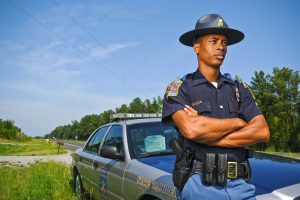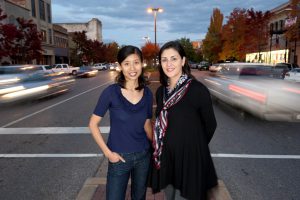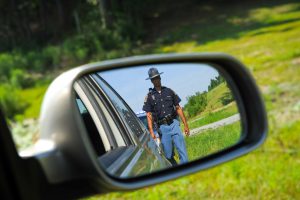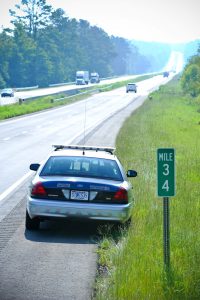By Bill Gerdes
Photography by Zach Riggins and Jeff Hanson
If you have been involved in a traffic accident in Alabama and received a ticket in the process, some folks at The University of Alabama want to thank you for making our highways safer.

A number of traffic-safety initiatives by the Alabama Department of Public Safety are based on traffic-accident information collected and analyzed by The University of Alabama’s Center for Advanced Public Safety, or CAPS, and operations management faculty and students at the Culverhouse College of Commerce and Business Administration.
One of the students, Shirley Li, a third-year doctoral student from China studying operations management, works with Dr. Burcu Keskin, assistant professor of operations management, in determining the best patrol routes for state troopers to maximize coverage along stretches of highways with high numbers of crashes. Traffic-safety researchers often refer to these stretches as “hot spots.”
Keskin says the research project began when Dr. Allen Parrish, director of CAPS, informed her of the center’s multiple databases available for traffic-safety research.
“I think what this really is about for state troopers is optimizing resources,” says Parrish. “You are trying to reduce the number of crashes and save lives. We are still early in the release cycle, and I think we will really see things start to change in five years or so.”
Parrish says the state troopers are accepting of the research and the suggested changes. “They are judged by the number of fatalities each year,” he says. The number of fatalities in Alabama dropped last year, and in 2009, but is up this year.
“But, state troopers are writing fewer tickets this year,” Parrish says. “Resources are scarce. They have half the number of troopers they need, and they want to put them where they will do the most good and not just generate revenue.’’
A FIRST-PLACE EFFORT

For her work on the project, Li earned first place in a recent poster competition at the Regional Transportation, Supply Chain and Logistics Management Workshop. Using real data from the state of Alabama, she provided recommendations for decision makers concerning the number of state troopers, the critical levels of highway coverage and dynamic changes in routes. The analysis can also be used to reallocate resources in the event of a potential budget cut or increase.
“This is important, as better state trooper coverage is believed to lead to fewer accidents, lower economic impact due to crashes and better road safety for everybody,” Keskin says. The research effort was supported by grants through the University Transportation Center for Alabama.

Others involved in the project are Dana Steil and Sarah Spiller. Steil, a former computer science doctoral student, initiated the hot-spot definition and investigation through his dissertation research. Spiller, a Computer-Based Honors Program student and finance major, helped with the data cleaning, a major task to efficiently use the information.
Keskin says Alabama state troopers are aware of the research, are familiar with the term “hot spot” and how to identify one and know the statistically-significant locations for accidents.
“And now they are more aware of those spots,” she says.
HOT SPOT, PART TWO
The current phase of the research, Keskin says, takes the definition of “hot spot” another step forward, and “says, ‘okay, we know where accidents are more prone to happen at certain locations, so how can we patrol those locations more efficiently and maybe avoid accidents happening all together?’ So, we are kind of on the second level of hot-spot identification.”
With the project’s funding renewed in 2011, Li is expanding it.
Keskin says in the first paper, she and Li ignored the fact that troopers may begin patrolling from different locations – such as their respective homes.
“We just concentrated on the state trooper post and started controlling from it. It was a simplification of the problem, but it helped us to get some modeling in and get some interesting results.”
“Another simplification we made, which may or may not be significant, is that we assumed they always travel at a constant speed of 60 miles an hour, but that can change depending on circumstances.
“In the second paper, we are trying to incorporate the dynamic traffic conditions, and state troopers patrolling from different starting places, into the model.”

So, the question becomes, does the information gleaned and analyzed suggest where state troopers should set up to catch speeders, drunks and reckless drivers?
“Yes,” Keskin says. “But, it is not so much the hiding spot but what spot, what mile post, should they choose to patrol. And I guess they can be creative about how they hide.
“When we received the data and identified hot spots, we were actually using citation data – ticket data. We were trying to use the tickets that correspond to accidents. If you just concentrate purely on ticket data, then the problems become a little bit shifted.
IT’S DYNAMIC
“Accident locations change all the time. The pattern of accidents is dynamic, and they are random, and even though this is a historical pattern, this model is not actually a statistical model.
“It is not like a state trooper goes to one place and sits there all day long. There is a dynamic pattern that changes with the shifts, the week and the day.
“Accidents have different patterns with respect to weekend and weekdays, with respect to morning and afternoon and evening shifts. But, once you build these results, based on the past few months of information, the results can be used for a while.”
The information used in the research goes from 2001 through 2008.
“The state troopers have been very supportive, and they are always looking forward to new knowledge they can take back and make improvements to their procedures,” Keskin says.
Does it occur to Keskin that she may be saving lives?
“I hope so. This is definitely an uplifting project for me to be involved in and take part in. I’m hoping I am helping some people … that using University resources and real data, our research does some good.
Is Keskin in the database?
“I am not. I had an accident, but it wasn’t my fault, and I did not get a ticket.”
Contact
Richard LeComte, UA Public Relations, 205/348-3782, rllecomte@ur.ua.edu
Source
Dr. Metka Zupancic, 205/348-5133; mzupanci@bama.ua.edu